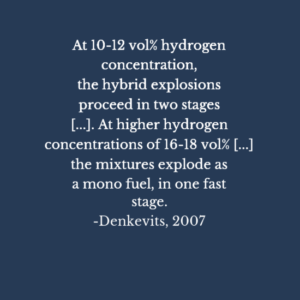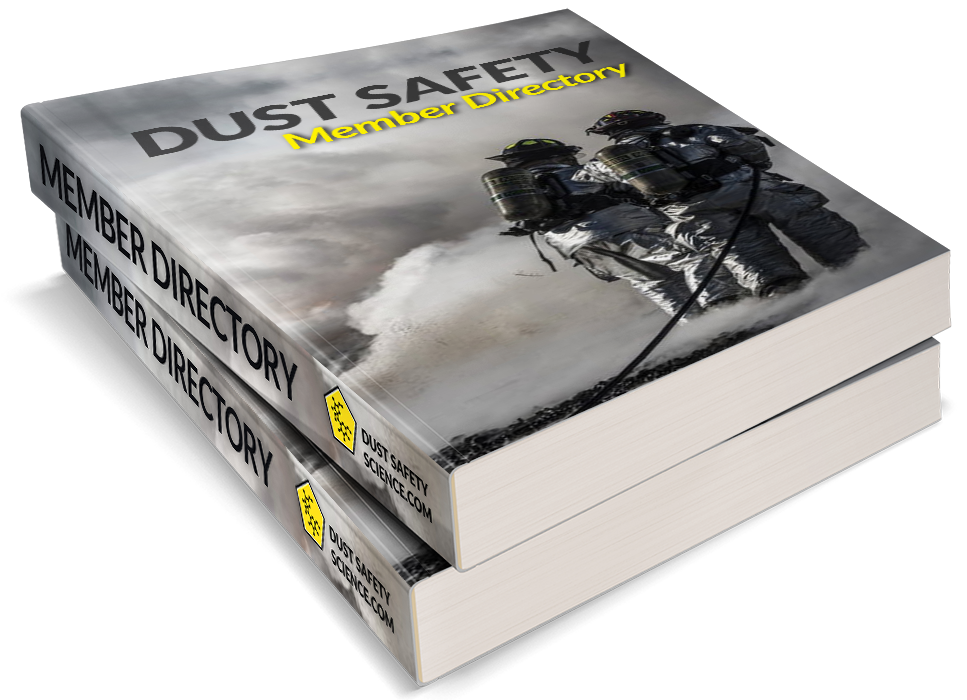1-Sentence-Summary: Using spark ignition hybrid mixtures of graphite dust and hydrogen gas are shown to expload in one of three possible processes : gas-only explosion, two-stage explosion, and single-stage or coupled explosion.
Authors: A. Denkevits
Read in: Three Minutes
Favourite quote from the paper:

This paper focuses on the explosion hazard presented by mixtures of fine graphite dust and hydrogen gas. These mixtures are a viable accident scenario in the thermonuclear industry where hydrogen can be released from malfunctioning vacuum pumps or as a result of beryllium-water reactions.
The author of this paper performs experimental explosion testing in a 20-L sphere using a weak electrical spark ignition. The graphite dust has a 4 µm average diameter and is tested from 25-250 g/m3. The hydrogen gas is tested from 8-18% by volume.
The explosion testing procedures were completed based on the German standards (VDI-Richtlinien, 1990) with an ignition delay of 60 ms. Pressure-time and pressure rise-time traces are shown for many of the hybrid mixtures along with maximum pressure and maximum rate of pressure rise verses dust concentration. In addition, the product gases after the explosion are analyzed to determine if dust combustion occurred during the exploson.
Three of the main findings from this paper are:
- At 8% hydrogen gas dust combustion does not contribute to the explosion process.
- Between 10% to 12% hydrogen gas the explosion proceeds in a two-step process where only maximum pressure can be increased due to dust combustion.
- At hydrogen concentrations higher than 16%, the explosion proceeds in a coupled single-step process where both pressure and rate of pressure rise can be increased due to dust combustion.
The following sections outline the main findings in more detail. The interested reader is encouraged to view the complete article at the link provided below.
Finding #1: At low gas concentration the dust does not ignite
At the lowest gas concentration tested (8%) the author found that the dust does not contribute to the explosion. Both maximum pressure and maximum rate of pressure rise decrease as the concentration of dust is increased. The authors also found that there where no carbon containing gaseous products in the post-explosion gases.
Under these conditions it would seem that the flame temperature of the hydrogen gas is not high enough to ignite the dust in the explosion timescale. At lower gas concentrations heat loss to the dust may act to quench the explosion itself. Note that at higher ignition energies (e.g., 1 to 2 kJ), the dust may be able to ignite directly.
Finding #2: At medium gas concentration a two-stage explosion process occurs
From 10-12% hydrogen gas concentration the explosion generally proceeds in a two-stage manner. The gas explosion occurs first, followed by the dust explosion. Under these conditions only the maximum pressure can be increased by the presence of the dust. Dust addition increases the maximum pressure until the post-explosion products analysis shows there is no oxygen left in the chamber. At higher dust concentrations the maximum pressure drops off due to heat loss.
Finding #3: At high gas concentration a single-stage explosion process occurs
At the highest gas concentrations tested (16-18%) a coupled explosion process was demonstrated. Under these conditions the flame temperature is high enough to ignite the dust in a similar time to the flame passage.
In the coupled explosion both the maximum pressure and maximum rate of pressure rise can increase with the addition of graphite dust. This suggests that a larger hazard is present than for the dust or gas alone, under the same concentrations. As in the two-stage explosion increasing the combined concentration above the effective stoichiometric limit (the combinations in which there is no oxygen left after combustion) decreases maximum pressure and maximum rate of pressure rise.
My Personal Take-Aways From
“Explosibility of Hydrogen–Graphite Dust Hybrid Mixtures”
Similar to the work of Pilao et al, 2006, this paper shows much more diagnostics than other papers in the field published in a similar timeframe. Seeing the pressure-time time traces for the hybrid mixtures is very informative and allows for a macro scale comparison of the combustion characteristics. The analysis of the post-explosion gases is also an interesting approach that could be used in other dust explosion experimentation work. This approach allows an estimate of the effective stochiometric concentrations during the dust explosion.
This work is very useful to review for researchers studying hybrid explosion phenomena. In particular the hazards associated with a mildly explosible dust and low ignition energies are demonstrated. Under non-hybrid conditions the dust could not explode with a weak spark ignition. This work is of particular interesting for those in the thermonuclear field, where graphite dust/hydrogen gas mixtures can be the result of typical accident scenarios. Other articles by this author such as Denkevits and Dorofeev, 2006, Denkevits, 2010, and Denkevits and Hoess, 2015, investigate the explosibility of graphite/tungsten, hydrogen/tungsten, and hydrogen/aluminum, respectively.
Full Citation: [bibtex file=references.bib key=Denkevits2007]
[otw_shortcode_button href=”http://www.sciencedirect.com/science/article/pii/S0950423007000617″ size=”medium” icon_position=”left” shape=”square”]> > Get The Article[/otw_shortcode_button]
